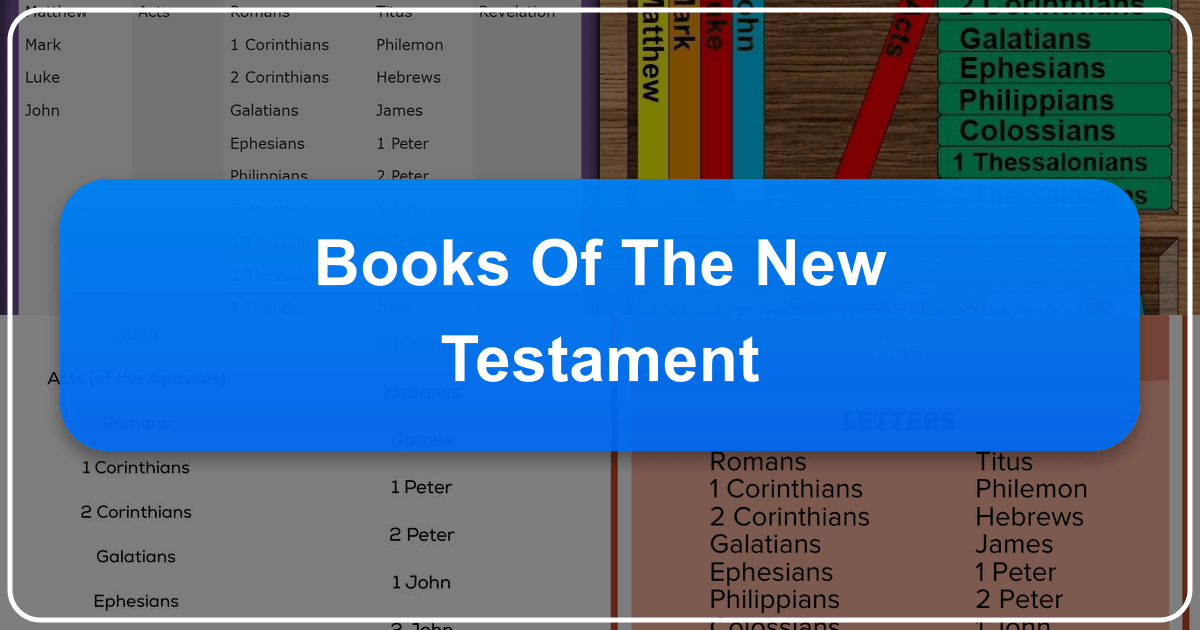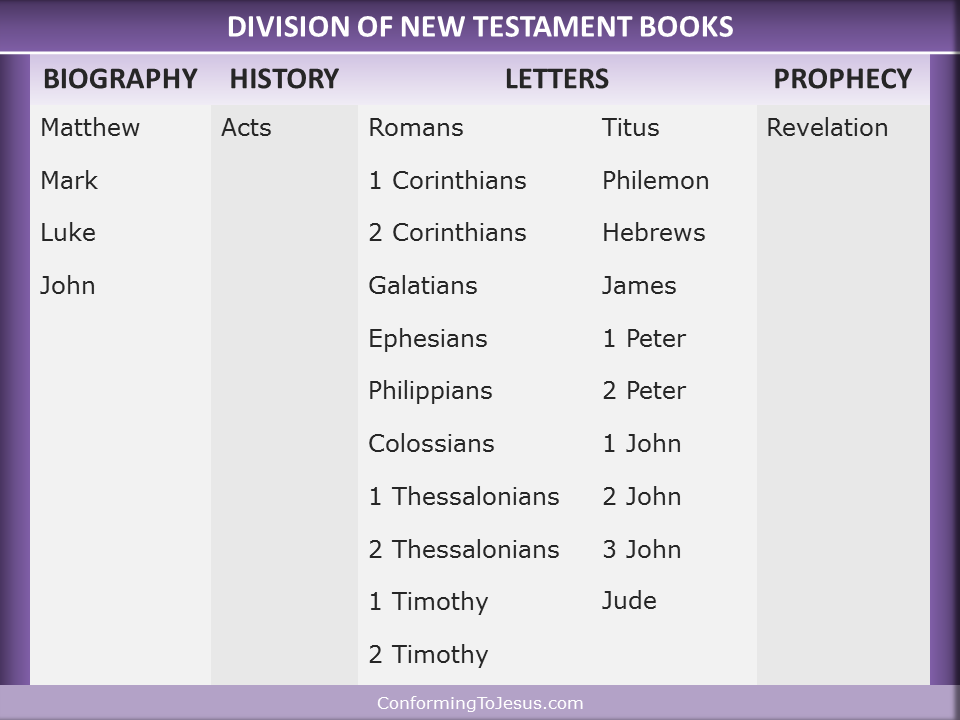The Books of the New Testament: A Comprehensive Guide

The New Testament, a cornerstone of Christian faith, comprises 27 books detailing the life, ministry, death, and resurrection of Jesus Christ, the subsequent establishment of the early Church, and its ongoing mission. Understanding the structure and content of these books, their authorship, and their historical and cultural impact is crucial for comprehending the narrative and theological richness of the New Testament. This guide provides a thorough exploration of the New Testament books, categorized by genre and examining various aspects relevant to readers, scholars, and those curious about its enduring influence.
1. Genre and Categorization of the New Testament Books
The 27 books of the New Testament are not randomly arranged. While the precise order isn’t divinely dictated, the grouping reflects a logical progression of the unfolding narrative and thematic development. The New Testament can be broadly classified into four distinct genres:

1.1 Gospels: Biographies of Jesus Christ
The Gospels (Matthew, Mark, Luke, and John) serve as biographical accounts of Jesus’ life, ministry, teachings, death, and resurrection. They offer multiple perspectives on the same central figure, enriching our understanding of his character, message, and significance. The first three Gospels (Matthew, Mark, and Luke) are often called the “Synoptic Gospels” due to their overlapping content and similar narrative structure. While there are some minor variations in detail, the core message of salvation through repentance and conformity to God remains consistent throughout. These minor discrepancies are not evidence of unreliability but rather reflect the perspectives of different eyewitnesses or narrators, similar to multiple accounts of a single event. The Gospel of John, distinct in style and emphasis, offers a deeper theological interpretation and highlights Jesus’ divine nature.
1.2 History: The Book of Acts

Acts of the Apostles, often considered a sequel to Luke’s Gospel, chronicles the expansion of the early Christian church following Jesus’ ascension. It details the work of the apostles, particularly Peter and Paul, as they spread the Gospel message throughout the Roman Empire. Acts provides invaluable historical context for the Epistles, offering insights into the circumstances surrounding their composition and the challenges faced by the burgeoning Christian communities.

1.3 Epistles (Letters): Diverse Teachings and Instructions
The Epistles (or Letters) comprise the largest portion of the New Testament. These letters, written by various apostles and church leaders to specific individuals or congregations, address a wide array of theological, ethical, and practical concerns. The collection is further categorized:
-
Pauline Epistles: Fourteen epistles are attributed to the Apostle Paul, reflecting his missionary journeys and theological insights. These letters cover diverse topics including justification by faith, the nature of the Church, the Christian life, and practical guidance for individual believers and communities. Some scholars divide Paul’s letters chronologically and thematically, such as grouping the “Prison Epistles” (Ephesians, Philippians, Colossians, and Philemon) written during his imprisonment in Rome.
-
General Epistles: Seven letters are attributed to other authors besides Paul: James, Peter (two epistles), John (three epistles), and Jude. These letters address issues relevant to the broader Christian community, offering encouragement, instruction, and warnings against various heresies and challenges.
1.4 Prophecy: The Book of Revelation
The Book of Revelation, often misunderstood as mysterious or enigmatic, stands apart as a book of apocalyptic prophecy. It unveils God’s ultimate triumph over evil and the future destiny of humanity and the cosmos. While symbolic language and imagery are used extensively, the book’s core message remains clear: God’s sovereignty and ultimate victory over all opposition. Understanding the historical context of Revelation and utilizing established principles of biblical interpretation are crucial for its proper understanding.
2. Authors and Their Writing Styles
The New Testament’s authorship is diverse, reflecting the contributions of different individuals with unique backgrounds, perspectives, and writing styles. While the precise authorship of some books remains a subject of scholarly debate, attributing the writings to specific individuals helps us understand the context and motivations behind their composition.
2.1 The Gospel Writers: Unique Perspectives on Jesus
Each Gospel writer presents Jesus from a slightly different angle, highlighting distinct aspects of his character and message. Matthew emphasizes Jesus’ kingship and fulfillment of Old Testament prophecies. Mark portrays Jesus as a powerful servant of God. Luke focuses on Jesus’ compassion and ministry to the marginalized. John unveils Jesus’ divine glory and identity as the Son of God.
2.2 Paul: The Apostle to the Gentiles
Paul, a prominent figure in the early Church, authored a significant portion of the New Testament’s epistles. His writing style is often characterized by passionate conviction and logical argumentation. His letters reveal a profound understanding of theology, especially concerning salvation by faith, the relationship between Jews and Gentiles in the Church, and the ethical challenges faced by early Christians.
2.3 Other Authors: Diverse Voices in the New Testament
Other authors, including James, Peter, John, and Jude, contribute their unique perspectives through their epistles. James emphasizes practical Christianity, while Peter emphasizes steadfast faith amidst persecution. John’s epistles convey deep theological insights and messages of love and fellowship. Jude delivers a powerful warning against false teachers. The authorship of Hebrews remains debated, although its profound theological insights and sophisticated literary style have ensured its place in the New Testament canon.
3. Reading, Learning, and Applying the New Testament
The New Testament is not merely a collection of ancient texts but a living, dynamic source of spiritual nourishment, instruction, and guidance. Engaging with the New Testament requires thoughtful reflection, interpretation, and application to contemporary life.
3.1 Summaries and Educational Value
Numerous resources exist to help readers understand the New Testament’s content and its overall message. Summaries of individual books or the entire New Testament provide an overview of the main themes and narratives, providing a useful starting point for in-depth study.
3.2 Life Lessons and Spiritual Growth
The New Testament offers a wealth of practical wisdom and spiritual guidance for navigating the challenges and opportunities of everyday life. Jesus’ teachings, the apostles’ experiences, and the letters to various communities offer valuable lessons on faith, love, forgiveness, justice, and many other relevant life lessons.
3.3 Developing Healthy Reading Habits
Engaging with the New Testament is a journey that requires consistent effort and mindful engagement. Reading plans, study guides, and group discussions can facilitate a richer understanding and promote reflection. Integrating Scripture reading into daily life, utilizing various study methods, and praying for divine illumination are crucial aspects of a fruitful engagement with the New Testament.
4. Accessing the New Testament: Libraries and Resources
The New Testament is readily accessible through various means. Traditional and digital libraries provide access to numerous translations and commentaries. Online platforms offer interactive versions with study tools, audio recordings, and videos that enhance understanding.
4.1 Public Libraries and Digital Archives
Public libraries offer a wealth of resources on the New Testament, including print Bibles, commentaries, and scholarly works. Many libraries also provide digital access to databases of biblical texts and related materials.
4.2 Online Resources and Digital Libraries
Websites and apps provide easy access to New Testament translations, study Bibles, commentaries, and devotional resources. Many institutions and organizations offer online archives containing rare manuscripts and historical documents related to the New Testament.
5. Cultural Impact and Enduring Legacy
The New Testament’s influence transcends religious boundaries, profoundly shaping Western culture, literature, art, and moral values. Its narratives, teachings, and ethical principles have provided inspiration for countless works of art, music, literature, and social movements.
5.1 Literary Influence and Adaptations
The New Testament has been a primary source of inspiration for numerous literary works, including novels, poems, plays, and films. Its themes and characters have been reinterpreted and adapted across various genres, demonstrating the enduring power of its narrative and ethical perspectives.
5.2 Communities and Global Impact
The New Testament has fostered a global community of believers united by shared faith and values. Christian communities worldwide draw inspiration and guidance from its teachings, impacting their daily lives, social interactions, and global outreach.
The New Testament, with its 27 books, stands as a testament to the enduring legacy of Jesus Christ and the transformative power of the Gospel message. By carefully examining its genre, understanding its authors, applying its teachings, and appreciating its historical and cultural impact, we can unlock the richness and relevance of this sacred text for our lives and our world.